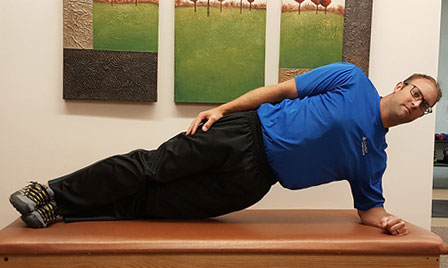If you want an exercise that engages most of your muscles in
one easy step, then you should plank.
The plank is a simple, effective bodyweight exercise that
strengthens your core, as well as muscles in your upper and lower body. Core
muscles, which include your back and abdomen, help you maintain posture and
balance as you stand, sit and move throughout the day.
The benefits of a strong
core are:
- Reduced back pain
- Reduced injuries
- Increased flexibility
- Improved balance and posture
- Improved mood
- Improved ability to conduct activities of daily
living
- Improved ability to participate in sports and
athletics
How to plank
As with starting any new exercise, check with your health
care provider to be sure you are healthy enough to plank. While there are a number of variations to the plank, let’s
start with the very basics. As you get better at planking, you can up the
difficulty level to reap further benefits.

- Lie on the ground as if you were going to do
a push-up.
- Squeeze your glutes and abdominal muscles as you
push up until your weight is supported on your forearms and your knees, with
your elbows below your shoulders.
- Keep your neck and back in a straight line (like
a plank of wood).
- Keep your eyes looking down at the floor.
- Hold the position, and remember to breathe.
As you become more comfortable with the plank, you should be
able to increase the time you spend holding the position. Your goal is to hold
it as long as possible without compromising the form or your breathing.
Aim for two to three sets of one to two minutes with 30 to 60 seconds rest
between sets.
Once you've mastered this position, try these alternatives:
Forearm, full leg: Straighten your legs so that you are supporting your weight on your forearms
and toes.

Full plank: Push
up with your hands until your arms are extended and your legs are straight
(looks like the top of a push-up).

Side plank: This
version helps strengthen your obliques (side muscles). Lie on your left side
and support your weight on your left forearm and the side of your left foot.
Repeat on the other side. Add difficulty by supporting your weight on your hand
instead of your forearm. You can also increase difficulty by raising your upper
arm into the air, as well as your upper leg.



Single-leg plank: Perform the full plank, but lift one leg in the air and hold. Repeat with the
opposite leg.

Elevated plank: Perform the full plank with your feet raised on a bench or step.

Things to avoid when planking
Remember, good form is the key to getting good results from
planking. Avoid these common mistakes:
- Holding your breath
- Placing your hands too close together which can
stress your shoulders
- Allowing your hips, head and shoulders to droop
- Arching your back
- Holding the plank after your form has collapsed














